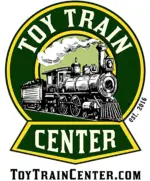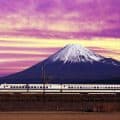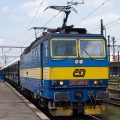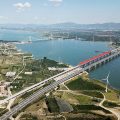The Shinkansen, commonly known as the “bullet train”, was built to connect all of Japan’s major hubs to Tokyo. It’s a spider web or hyper-efficient railway networks that has helped Japan become one of the biggest cultural and economic powerhouses in the world. Its railway is arguably second to none and one of the most fascinating testaments to the capabilities of human engineering.
Here are 25 amazing facts about Shinkansen, the Japanese Bullet Train:
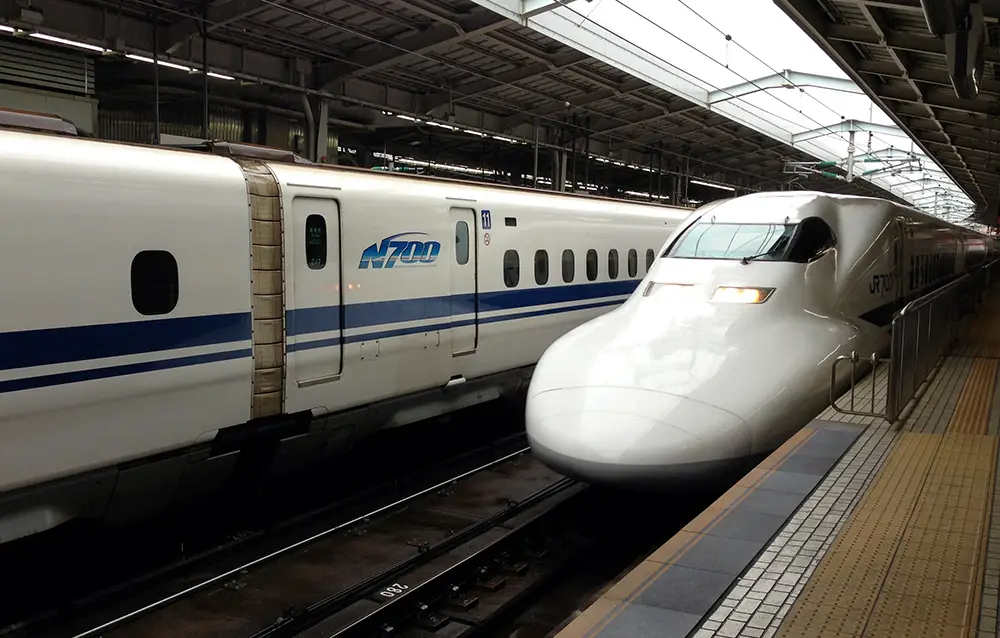
#1 – The name Shinkansen is not the first name that the trains have owned. In the 1940s, they were originally called Dangan Ressha, which when translated to English means “bullet train”, hence why they are known as that by English speaking people all over the world. The newer models have since been renamed to Shinkansen, which means New Truck Line.
#2 – The plan to build a high-speed rail network in Japan has been around since 1887. Even back then, when trains first began appearing in Japan, the groundwork was beginning to be laid. It took 53 years for the project to really get going, largely because World Was 2 set the country’s progress back. Once the war was over, the Japanese government had the time, money, and manpower to really focus on this countrywide project.
#3 – There was a period in the 1950s where faith in a high-speed rail network began to falter. It was around this time that the production of cars and usage of planes began to really ramp up, and many of the transportation department government officials began to grow concerned. Should they switch their focus to air travel and automobile? It was decided that the project would continue, a major factor being so much work had already been done. Because the groundwork had been laid, it was still cost-effective to focus on the high-speed railway. But they knew their railway had to be the best if they it was going to be able to compete with road and air travel.
#4 – The original countrywide railway lines were 1,067mm gauge, which is much smaller than the modern wide gauge track. This small gauge track is not suitable for the incredibly high speeds they planned to reach with their new Shinkansen trains. This meant that a new track had to be laid all over the country, not an easy task. Most other developed countries already used broad gauge, so they did not need to relay their whole network. This meant Japan was set back behind the leaders of the pack in modern rail advancement. Though it worked to their advantage, it gave them more freedom to build more efficient lines and more time to design better quality trains, stations, and tracks.
#5 – The first Shinkansen line completed was the Tokyo to Osaka route. This route took 6 years to build, in part because the track had to be completely relaid and in some places, tunnels needed widening. The building process was sped up drastically to make sure it was ready for the 1964 Tokyo Summer Olympics. The full build timespan for this route was from 1959 to 1964.
#6 – The very first Shinkansen line (Tokyo-Osaka) was an incredible success. By 1967, only three years after it first opened, 100 million passengers had already traveled on this one route. 9 years after that, in 1976, they hit the 1 billion passenger mark. Such a huge success was proof enough that sticking to their guns and continuing the Shinkansen project was absolutely the correct decision.
#7 – Even the earliest Shinkansen trains ran at speeds of 200km per hour, which was almost completely unprecedented. Trains were capable of reaching these speeds, of course, but not on such a huge scale with such regularity. Some of these original cars were saved in museums as a memento, one even made its way to the British National Railway Museum.
#8 – Nowadays, the average speed on this railway is about 300km per hour. Only the French TGV trains and German ICE trains can somewhat compete with those of Japan. The drastic jump up in speed is only the beginning, there is certain to be steady improvements. It is a very real possibility that trains will one day compete with the speed of air travel. That would certainly be more convenient.
#9 – The original Shinkansen could make the Tokyo-Osaka run in around 4 hours covering a distance of about 500km. Now it can be done in two-thirds of that time but the cost is also about six times higher than it once was. It is up for you to decide whether you think the increase in price is worth the extra speed. (It costs about $132 US for a one-way ticket!)
#10 – Unlike many other modern railway lines, the Shinkansen trains are purely for passengers. Although they were originally planned for shipping freighters too, like other countries’ high-speed railways, it was decided that they would not. They opted to instead spend more time each night running track maintenance and keeping their trains in the best of condition. This contributes to them being some of the safest trains in the world.

#11 – To say the Japanese railway system is punctual would be an understatement. Their schedule keeping ability is absolutely immaculate. It sounds hyperbolic to phrase it that way, but there really is no other way to say it and do it justice. Japanese trains are scheduled down to the centisecond. If they are one second late, they are classed as late. If you compare this to the American railways, such as Amtrak, there is a glaring difference. If an Amtrak train arrives less than 10 minutes late, it is counted as technically on time. If a Japanese train is 10 minutes late, something has gone terribly wrong.
This article contains more information about how punctual Japanese trains are. It is, however, an English translation of a Japanese article. So although it does make sense, it has poor grammar.
#12 – If you are from India or even some Western countries, you are probably used to your train not turning up on time. Your train being late to arrive, late to set off, and late arriving at your destination is probably not an uncommon occurrence. If you are a work commuter, you may even be able to use this as an excuse for being late to work. Not in Japan. A train being significantly late is so rare that slips of paper explaining your train was delayed are provided as evidence to give to your employer.
#13 – The average delay for one train in one year is about 56 seconds, which is worse than its 2016 delay average of 26 seconds. PER YEAR. That means that a Shinkansen train arrives on average within a fraction of a second that it was scheduled to arrive. You may get away with turning up late to the station and still making your train in other countries, but not Japan.
#14 – On the off chance that your train is over 2 hours late, which could only really be caused by severe weather, your ticket will be refunded. The chance of this happening is incredibly slim, as snowstorms bad enough to stop the trains are incredibly uncommon occurrences.
Watch this amazing video about how the Shinkansen came into being:
Video Credit: Mustard – Click Here to watch directly on YouTube
#15 – Japan has set the stage for what high-speed trains can and should be capable of, and their dedication to punctuality, safety, and overall efficiency is second to none, no questions asked. At least, it was for a while. China has quickly begun to catch up, its rail network is now one of the most extensive in the world, its trains just as fast in some places and its stations just as impressive. It does not have the punctuality or passenger numbers that Japan does, though. China is trying to make its railway the best in the world and the country is making ginormous steps. Hopefully, this will pushes Japan to improve theirs even further. Progress is good for the passengers after all, not just each country’s pride.
This Business Insider article contains a detailed comparison between the Chinese and Japanese high-speed rail systems (as well as comparing Russia’s and Korea’s).
#16 – The Shinkansen trains ran for around 50 years before they had even one derailment. This derailment was caused by the devastating 2006 earthquakes in Chuetsu. One passenger train near Nagaoka station had 6 out of its 8 carriages derailed.
#17 – One of the biggest hurdles the Shinkansen engineers have yet to overcome, is noise. It is currently possible to make the trains go even faster, but their noise pollution is a huge issue for surrounding areas. That makes lowering their volume one of the main priorities for future models (inside, the trains are super quiet!).
#18 – Whilst noise is a big problem, it is mostly harmless. Just unpleasant. What is a problem though, is the sonic boom caused by the trains exiting the tunnels. Sonic booms are loud, hence the boom, but also incredibly powerful. It is capable of shattering glass and eardrums, when too close to the source. If they can find an efficient way to stop these sonic booms, they will be able to increase speed without risking damage to the tunnels’ surrounding.
#19 – Shinkansen trains are the most popular high-speed trains in the world. But their percentage share of ridership out of all high-speed passengers around the world is dropping, as other countries develop high-speed rail travel. Even so, as of 2014 they had 57.4% of all high-speed rail passengers of the entire planet. An impressive achievement.
Photo source: Wikimedia Commons
#20 – As of 2014, the Shinkansen has provided transport to over 11 billion passengers. Comparatively, all of Europe’s high-speed rails have only transported 4.3 million people. Considering that Japan’s population is about one-sixth of the size of Europe, this is just an amazing statistic.
#21 – The Shinkansen rail coverage has expanded steadily over its nearly 60 years since the first line opened. Today, the Shinkansen covers 2,764km of rail. To help give you an idea just how much coverage this is, the entire length of Japan is about 3,000km.
#22 – Shinkansens that operated in the 1960s had their names chosen by the general public. The public was encouraged to send in suggestions which would then be picked from. Over half a million suggestions were sent when, at that time, Japan’s population was 96 million. Meaning about 0.5% of the population of Japan cared enough to vote, that’s how popular these trains are in the Land of the Rising Sun.
#23 – One of the best ways to see all of Japan has to offer is to buy the 7-day JR Pass. The pass cost about $270 US. This seems quite a bit for a train pass, but it is such good value for money when you consider just how much of Japan you would be able to cover (almost all of the country, if you had time to) and how much one train ride costs.
#24 – Although the average operating speed is 300km per hour, there is a 387km section of track that the trains can maintain a steady 320km per hour on. This is the fastest stretch that they are currently able to cover for public use.
#25 – The SCMaglev (the superconducting maglev) is not for public use, but it did manage to set a world record of 603km per hour in 2015. This shattered previous records. Sadly, it is not yet feasible for all Shinkansen to be this fast, but with another 50 years of engineering, I have no doubt they will be. After all, only 150 years ago the record was about 150km per hour. Who knows what the future brings?
The CNBC has a really cool article about SCMaglev here.
The Shinkansen is an incredible feat of engineering. Whether you are looking for incredible speed, scenic views, cool trains or simply the most efficient way of seeing Japan, this is the way to go. Japan has paved the way for high-speed trains of the future, who knows what they will manage to achieve in the next 50 – 100 years? They have done so much in such short a time, whatever they have in store next will be incredible, I’m sure.
You might also like the following facts about the best railway journeys in the world:
- 25 Amazing Facts About the Euro Rail & Eurail
- 25 Amazing Facts About the Trans-Siberian Railway
- 25 Amazing Facts About the Thai-Burma Railway
- 25 Amazing Facts About the Amtrak Railway
- 25 Amazing Facts About the Orient Express
- 25 Amazing Facts About the Bangkok-Ayutthaya Railway
- 25 Amazing facts About the Trans-Mongolian Railway
- 25 Amazing Facts About the Beijing-Lhasa Railway
